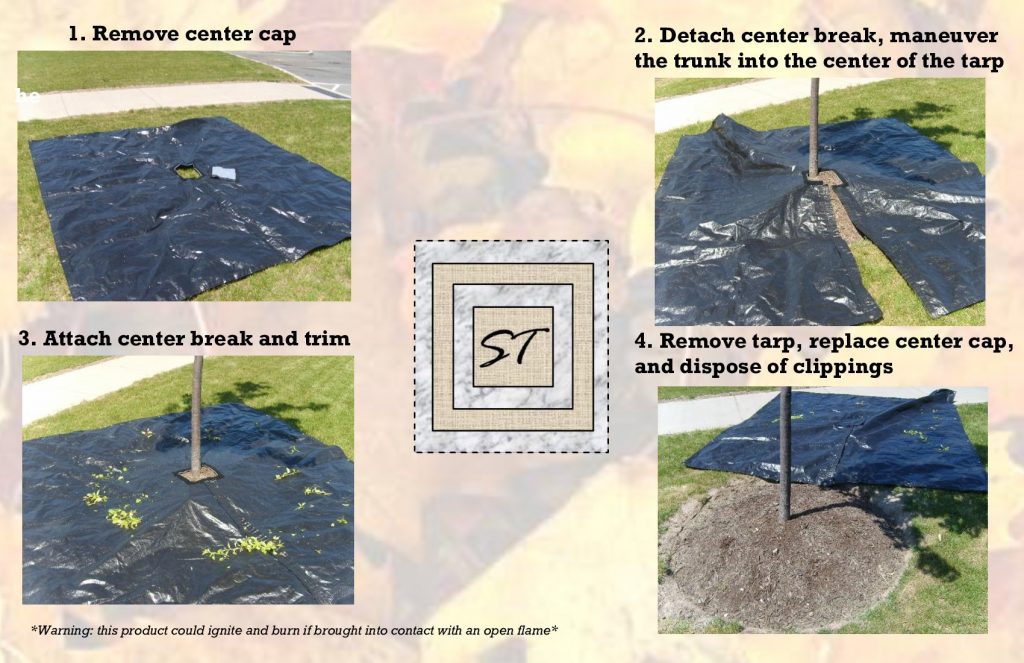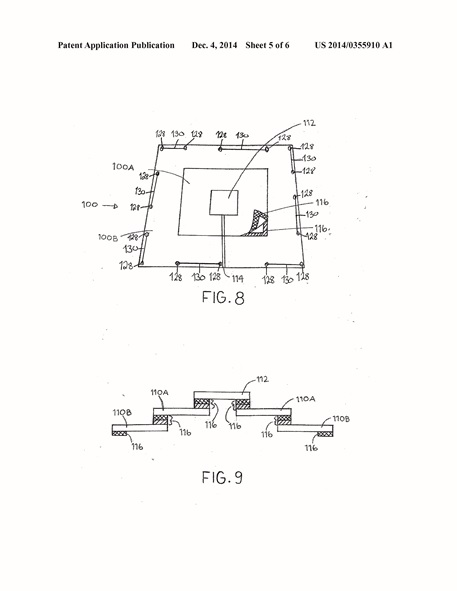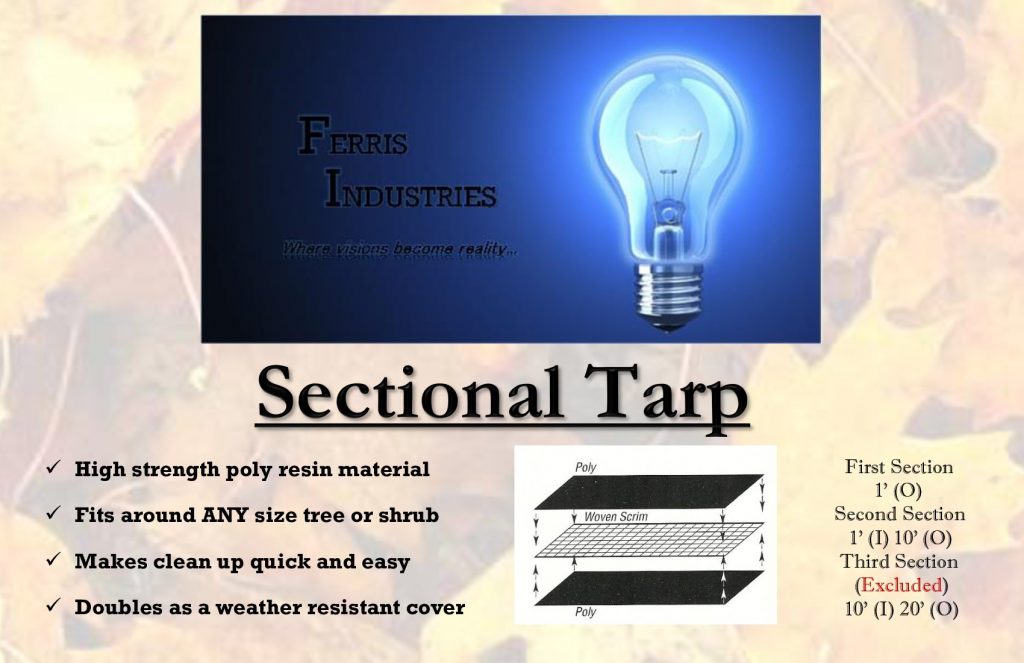Every great invention starts with a problem. For Ryan Ferris, that problem came in the form of the pesky mess left behind after trimming trees and shrubs. How could landscapers make their clean up job easier? How could homeowners maintain their own landscapes without the added stress of clean up? With those questions, the Sectional Tarp was created, and a Kickstarter started! We sat down with Ryan to get the inside scoop on the next big thing.
For more information, check out Ryan’s Kickstarter page! You can also learn more about Ryan on social media: Facebook and LinkedIn.
1: What is the big “problem” that you are solving? Where is the customer pain?
The big problem is during the landscaping process when trimming trees or shrubs, a mess is made. All the clippings from trees and shrubs end up in a mulch garden, rock garden, or flower bed. It is then the obligation of the landscape company to remove all of these clippings from these areas, which is a very time-consuming process. This cleanup process can take more time than it does to actually trim these trees or shrubs! The pain occurs when a company has to pay an individual anywhere between eight and fifteen dollars an hour to have them sitting or crouch down on their hands and knees handpicking all of these clippings out of each of these different style of beds, when there always seems to be leftovers upon completion. Not only can one save time by utilizing the Sectional Tarp but there are other costs that can be saved as well, such as costs related to having to replace or “dust” a customers’ mulch bed in order to hide all of the fresh clippings.
2: How is this problem currently being dealt with (if at all)?
Currently there are few options that one has in getting rid of these clippings. I’ve heard stories of people taking a sheet, cutting a slit in it and utilizing that as how the Sectional Tarp would be used. There are many problems with this, such as once their sheet is cut they will have a “tool” that will not be able to hold anything including tree clippings. Once the pruning process has been completed and they have tried to dispose of the clippings that have fallen onto the sheet, there is nothing to hold them inside and therefore eventually losing these clippings in their beds or yard, bringing them back to stage one of the cleanup process or potentially making more work for themselves.
One can also purchase a landscape vacuum to suck up said clippings but once again, problems arise. Firstly, these vacuums can cost hundreds of dollars and will eventually break down and need repairs, which will be costly as well. Secondly, the problem with these vacuums is mulch is very light. People end up sucking up most of their mulch as well as the clippings, completely eliminating entire objective of the cleaning up process. And lastly, the traditional raking and handpicking. It is most common for a landscape company to pay an individual to “carefully” rake these clippings from each of these beds to get the majority out, then handpick the larger pieces out to eliminate majority of these clippings. Once finished, they will dust (hand tossing a very thin layer of mulch) or re-spread mulch to hide the rest, which in my eyes seems a little knavish, but is a very common practice.
3: What is your solution? In what ways is your solution better?
his product will more than pay for itself just in the first use, whether it be the time saved during the cleanup process while a landscape crew was able to complete another job or by an individual saving hundreds of dollars not having to pay a professional team of landscapers to clean up a mess. This way the homeowner would be able to tackle the project on their own due to the most time-consuming, boring, and frustrating aspect of the job has been eliminated. This product is made to fit around the underside of trees and shrubs, catch clippings that vary in size, from the size of a pebble to a full tree branch if necessary, and then be able to once again break apart and be put back together as if it were a full tarp. Due to its size and high-strength material, once removed, all that has to be done is it be dragged away with all these various sized clippings, leaving the user not having to worry about losing a single clipping in the process. Most of the traditional tarps that one finds today are made out of a blue polyethylene material that over a short period of time deteriorate from normal usage and abuse. The Sectional Tarp is made out of a high-strength polyethylene material containing a sandwiched woven scrim, which will provide the extra necessary strength in hauling large loads of debris as well as adding a considerable amount of life onto the product whether it undergoes normal wear and tear or anything extra. Another area that makes the Sectional Tarp better than most is, that unlike a vacuum which may be technical, the Sectional Tarp is very easy to use and very easy to understand making it user-friendly and every aspect. The Sectional Tarp has every use as a normal tarp would plus the aspect of high-strength, the aspect of being able to fit snug on the underside of a tree or shrub, the ability to expand indefinitely if need be. It also folds up neatly and tightly for easy storage and has the ability to be used as a weather resistant cover.
The Sectional Tarp can be used is a weather resistant cover by utilizing grommets on the outermost edge by weaving a piece of string or any other fibrous material in and out of said grommets, placing the Sectional Tarp over the desired object that is wanting to be covered, finally tightening up what would now be considered the base (containing the string and grommets) creating a tight seal around the object. Due to the specific layering of each of the sections on the Sectional Tarp, for example if it starts to rain the layering will act as shingles by having the liquid dripping off the product and not inside, potentially damaging or ruining the object being covered. Since the Sectional Tarp can expand to in essence an infinite size, the objects one wishes to cover is limitless!

4: How many people have this problem? Where are they located? How costly is this problem (what will someone pay to deal with the problem?)?
This problem occurs in absolutely every landscaping company and with any individual that does landscaping on their own. The process of creating a mess to ensure the clean-cut look, or natural look of one’s trees or shrubs is perpetual during the pruning process with cleaning up being a necessity. Landscaping occurs everywhere, which means not only here in the US but worldwide as well. Some of these companies or individuals will understand this cleanup process is undesirable and time-consuming but do not have the understanding or resources to purchase, create, or consider a product like the Sectional Tarp to aid during this process. Once the Sectional Tarp has made its debut in to the market, I am confident that people will recognize and understand the utility of the product; it will be an essential tool in every landscaper’s and homeowner’s tool shed.
5: What kinds of competition exist or may surface (including existing and emerging competitors/products/technologies)?
Currently there really is no true competition for the Sectional Tarp. The only competitors consist of regular rectangular shaped tarps, which do not have the capability of sitting snug around a tree or shrub without substantially altering its shape, nor have the capability of being able to expand. There are also no landscaping vacuums that are as inexpensive as the Sectional Tarp or as efficient with removal of specifically clippings. Down the road I’m sure there are definitely going to be companies that try to replicate the Sectional Tarp, trying produce and sell them at a cheaper cost. With a patent currently in a pending status, it will make it almost impossible for a company to produce a product that is similar.
6: Is your idea proprietary (protectable through patent, trade secret, trademark, copyright) or is it a “first to market” type  opportunity?
opportunity?
The Sectional Tarp is currently patent pending which protects the utility and design, also allowing myself to market the product until a final decision is made from the patent office. With a patent search we found that there are similar ideas in regards to the Sectional Tarp, but nothing that is such an all-inclusive product with multiple usages. Despite having found these similar patents, currently in the market I have not seen any products that resemble what the Sectional Tarps’ function is. The closest thing out on the market currently is your typical landscape tarp, which as stated before is a plain rectangular tarp, and that’s it! I believe the Sectional Tarp would be a first to market type opportunity due to having worked at a handful of different landscaping companies and not one of them had a product like this. Not only did they not have similar products but some companies that I worked for did not even utilize a tarp in general, which in my eyes is crazy! I’ve been told by former landscapers, business owners, and homeowners that once the Sectional Tarp is available, that they will certainly be making multiple orders to purchase this product due to its convenience, price, and time-saving capabilities.
7: What are your sources of Sustainable Competitive Advantage? Can you develop any?
The competitive advantage would be completely in the product’s patent pending design. Later down the road once vertical integration has been established, I can manufacture and sell the product through Ferris Industries LLC alone. Further technological advances also will be able to provide a better product with better pricing, creating yet another advantage.
8: Is this a “one trick pony” or is this a “platform technology”? What might 2nd or 3rd generation products look like?
I would consider the Sectional Tarp a platform technology due to there will certainly be newer and better products to come out down the line. Later generations of the Sectional Tarp will certainly have the same design and similar utility of the original but may consist of different materials, different colors which also can be customizable to where one can upload a photo that will be presented on the face or upper half of the tarp; such as a company logo or camouflage design. Lastly, different sized tarps that will accommodate for almost an infinite variety of shrubs or trees. This will be accomplished by each layer of the Sectional Tarp comes equipped with the industrial hook and loop tape attached to the outer perimeter for expansion purposes. Say an individual has a tree with a canopy over 10 feet. A third section will be available for purchase to expand the 10 foot by 10 foot tarp into a 20 by 20 foot tarp. With the option to infinitely expand and shrink the Sectional Tarp, there is no tree or shrub that this product can’t catch clippings from.
Also a completely biodegradable mesh version will eventually be available so that one can place the product underneath trees and shrubs during the fall season. Once all the leaves have fallen to the ground, one can roll up each of the sections and place them at the curb for disposal. The mesh feature will allow the grass beneath to continually grow during this time and not be harmful to an individual’s lawn.

9: Am I having fun?
Absolutely, despite the initial period in which the idea originated from. By this I mean throughout the years of landscaping my frustration is what brought the idea of the Sectional Tarp into reality. There were times that I got so frustrated of having to be bent over, or on my hands and knees for hours trying to gather all the tree clippings in order for the customer’s property to look as beautiful as it did before and better. Despite that initial phase causing the innovation of this product, I’m finding this process of bringing the Sectional Tarp to life very fun and exciting! I’ve always said that knowledge is contagious and I truly have enjoyed learning how to create this product from scratch, obtain a current patent pending status, and now starting a business. This has genuinely been satisfying for me and will continue to put a smile on my face and hopefully others knowing that time and money can be saved by using this product. I will continue to have excitement for further progression of this company down the road and look forward to the path ahead of me. Overall, all this process has forced me to focus on mastering major life skills such as time management, communication, manufacturing, and networking.
10: What will be included in the shipment to each backer?
What will be included in the shipment to each backer will vary depending on pledge amount. The main difference will be the quantity of tarps included. Each backer will also receive a small hand written note from our team personally thanking them for their support. A product flier will also be included which provides directions on how to use the Sectional Tarp.

11: How long will it take to receive my Sectional Tarp?
The campaign will run for 43 days so that starting on the first day and every third day after that an update can be made if necessary. Manufacturing time for the first 3000 units is scheduled for 40 days plus or minus three, including the shipping time to Raleigh, North Carolina. Once the initial order has been placed and momentum has begun, shipping time to our warehouse will be much quicker, allowing myself and my team to package and ship each individual order in a timely consistent fashion. If successful, I will post updates on a weekly basis enlightening each of our backers on which numbers have been sent out and which numbers will be completed during the following week.

12: Thank You!
I thought it would be nice to add one last section here genuinely expressing my thanks to everyone that has taken the time to read through all of this information and has decided that the Sectional Tarp is a tool that will be essential in your toolbox. I have spent years testing and revamping the design, specifically choosing the correct materials that will make this product outlast all of the other tarps you have. Once again, thank you for your support and thank you for believing in the Sectional Tarp!









